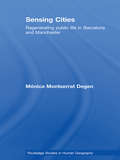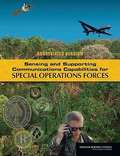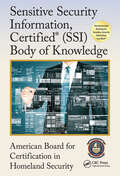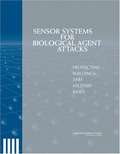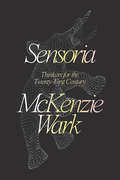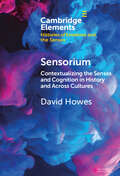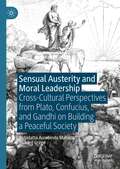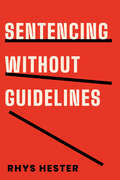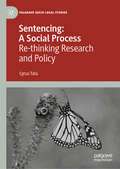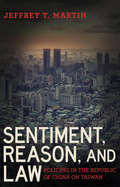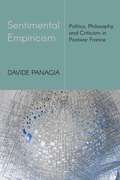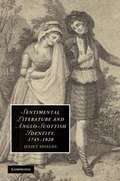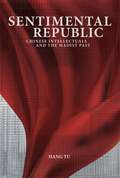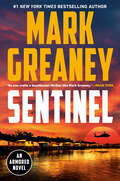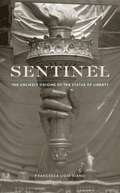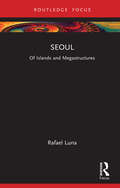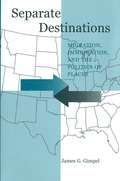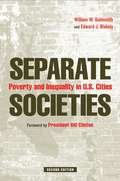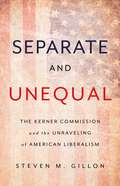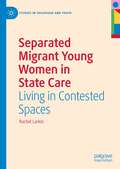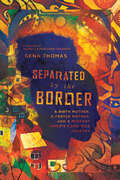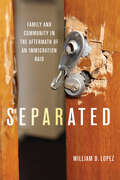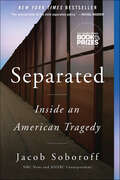- Table View
- List View
Sensing Cities: Regenerating Public Life in Barcelona and Manchester (Routledge Studies in Human Geography #14)
by Monica DegenAs cities globally re-design their urban landscapes, they produce a different urban aesthetic and create new experiential milieus. Urban regeneration processes generate radical physical, social and cultural changes in neighbourhoods that demand new conceptual frameworks to address their impact upon daily urban life. Sensing Cities investigates the reconfiguration of contemporary public space and life through the prism of the senses. The book explores how the increased stylization of cityscapes requires an understanding of public life as a spatial-sensuous encounter. Degen examines how power relations in public spaces are embedded in, exercised and resisted through the sensuous geography of place. This sensory paradigm is then applied to compare two emblematic regeneration projects, namely el Raval in Barcelona and Castlefield in Manchester. By combining detailed ethnographic analysis and interviews with those involved in planning regeneration processes and those experiencing them, the book argues that a changing sensuous landscape is crucial in redefining people’s social practices, attachments and experiences in places. Focusing on two European cities at the forefront of urban design, Barcelona and Manchester, Degen draws on sociology, geography, anthropology, cultural and architectural studies to provide a critical account of the politics of publicness in the entrepreneurial city. With numerous photographs and maps this book stresses the ongoing, embodied and active nature of regeneration as a lived social process rather than merely a physical or economic exercise. Ultimately, Sensing Cities examines how urban regeneration is made effective through the organisation of sensory experience. This book is essential reading for students and researchers of Architecture, Urban Studies and Human Geography.
Sensing and Supporting Communications Capabilities for Special Operations Forces
by National Research Council of the National AcademiesAmong its key responsibilities, The U.S. Special Operations Command (SOCOM) plans and synchronizes operations against terrorist networks. At any given moment, SOF are likely to be engaged in some stage of the planning or execution of special operations in many countries around the world, spanning a wide range of environments and missions. SOF therefore must be capable of operating in environments ranging from tropical jungle to arctic, maritime to desert, subterranean to mountainous, and rural to urban. Within this vast range, additional factors may influence technical and operational requirements, including weather, topography, bathymetry, geology, flora, fauna, and human population density. All of these factors must be weighed in terms of the challenges they pose to supporting communications and operational security. In short, SOF must maintain the capability to operate globally, in any environment, against any threats that can be countered by its unique capabilities. Sensing and Supporting Communications Capabilities for Special Operations Forces focuses primarily on the key core SOF task of special reconnaissance, to determine SOF-specific sensing and supporting communications needs and mapping them to existing and emerging technologies. The book discusses preliminary observations, issues, and challenges, and identifies additional capabilities and technology areas that should be addressed.
Sensitive Security Information, Certified® (SSI) Body of Knowledge
by 0 American Board for Certification in Homeland Security"Sensitive security information (SSI) is a category of sensitive but unclassified information under the United States government's information sharing and control rules. SSI plays a crucial role in all types of security. It is information obtained in the conduct of security activities which, if publicly disclosed, would constitute an unwarranted in
Sensor Systems for Biological Agent Attacks: Protecting Buildings and Military Bases
by National Research Council of the National AcademiesOver the last ten years, there has been growing concern about potential biological attacks on the nation’s population and its military facilities. It is now possible to detect such attacks quickly enough to permit treatment of potential victims prior to the onset of symptoms. The capability to “detect to warn”, that is in time to take action to minimize human exposure, however, is still lacking. To help achieve such a capability, the Defense Threat Reduction Agency (DTRA) asked the National Research Council (NRC) to assess the development path for “detect to warn” sensors systems. This report presents the results of this assessment including analysis of scenarios for protecting facilities, sensor requirements, and detection technologies and systems. Findings and recommendations are provided for the most probable path to achieve a detect-to-warn capability and potential technological breakthroughs that could accelerate its attainment.
Sensoria: Thinkers for the Twentieth-First Century
by McKenzie WarkDesign, Politics, the Environment: a survey of the key thinkers and ideas that are rebuilding the world in the shadow of the anthropoceneAs we face the compounded crises of late capitalism, environmental catastrophe and technological transformation, who are the thinkers and the ideas who will allow us to understand the world we live in? McKenzie Wark surveys three areas at the cutting edge of current critical thinking: design, environment, technology and introduces us to the thinking of nineteen major writers. Each chapter is a concise account of an individual thinker, providing useful context and connections to the work of the others.The authors include: Sianne Ngai, Kodwo Eshun, Lisa Nakamura, Hito Steyerl, Yves Citton, Randy Martin, Jackie Wang, Anna Lowenhaupt Tsing, Achille Mbembe, Deborah Danowich and Eduardo Viveiros de Castro, Eyal Weizman, Cory Doctorow, Benjamin Bratton, Tiziana Terranova, Keller Easterling, Jussi Parikka.Wark argues that we are too often told that expertise is obtained by specialisation. Sensoria connects the themes and arguments across intellectual silos. They explore the edges of disciplines to show how we might know the world: through the study of culture, the different notions of how we create such things, and the impact that the machines that we devise have had upon us. The book is a vital and timely introduction to the future both as a warning but also as a road map on how we might find our way out of the current crisis.
Sensorium: Contextualizing the Senses and Cognition in History and Across Cultures (Elements in Histories of Emotions and the Senses)
by David HowesDo the senses have a history? How many might there be? Are the senses so many independent channels, or do they interact with and modulate each other? If so, how might we cultivate the capacity to see feelingly or hear colours? What makes smell 'the affective sense'? These are among the questions to be addressed in this Element. It pries the senses and perception loose from the psychology laboratory to focus on how they have been constructed and lived differently in different historical periods and across cultures. Many of its findings are surprising because they run counter to our common-sense assumptions about the sensorium. They make uncommon sense. Plus the reader will meet some fascinating historical characters like the prolific 17th century natural philosopher Margaret Cavendish (also author of the play The Convent of Pleasure) and the late 19th century artist James McNeill Whistler, who infused his paintings with music.
Sensory Perception, History and Geology: The Afterlife of Molyneux's Question in British, American and Australian Landscape Painting and Cultural Thought (Elements in Histories of Emotions and the Senses)
by Richard ReadWiiliam Molyneux's question to John Locke about whether a blind man restored to sight could name the difference between a cube and a sphere without touching them shaped fundamental conflicts in philosophy, theology and science between empirical and idealist answers that are radically alien to current ways of seeing and feeling, but were born of colonizing ambitions whose devastating genocidal and ecocidal consequences intensify today. This Element demonstrates how landscape paintings of unfamiliar terrains required historical and geological subject matter to supply tactile associations for empirical recognition of space, whereas idealism conferred unmediated but no less coercive sensory access. Close visual and verbal analysis using photographs of pictorial sites trace vividly different responses to the Question from William Hazlitt and John Ruskin in Britain to nineteenth-century authors and artists in the United States and Australia, including Ralph Waldo Emerson, Thomas Cole, William Haseltine, Fitz Henry Lane and Eugene von Guérard.
Sensual Austerity and Moral Leadership: Cross-Cultural Perspectives from Plato, Confucius, and Gandhi on Building a Peaceful Society
by Debidatta Aurobinda Mahapatra Richard GregoThis book examines the link between sensual austerity and moral leadership—a topic largely neglected in contemporary academic scholarship and public policy—by exploring the comparative cross-cultural perspectives of Plato, Confucius, and Gandhi, on this theme. Despite the diverse cultural contexts that gave rise to their respective philosophical perspectives, they shared similar views on what might constitute a universal and perennial basis for individual moral development in any harmonious political order. They all agreed that sensual austerity is necessary for the realization of a flourishing society and political culture: recognizing that control over sensual desire is both a vehicle for individual moral self-cultivation and social-political progress. Sensual austerity is thus an essential aspect of any morally governed person, institution, state, or society. The book also argues that further examination of this theme may assist scholars and policymakers in developing more peaceful and harmonious national and global communities.
Sentencing without Guidelines
by Rhys HesterSentencing matters. Reform initiatives hope to impart more uniformity and fairness in sentencing. Tough-on-crime laws like “three strikes” and mandatory minimum provisions deprive judges of sentencing discretion. While sentencing guidelines have been adopted by approximately 20 states since the early 1980s, many judges operate without guidelines. Sentencing without Guidelines is Rhys Hester’s deep dive into how South Carolina, which never passed sentencing guideline legislation, nonetheless created meaningful punishment reform. It achieved uniformity in sentencing with a traveling circuit of judges, informal norms among judges, and the unique phenomenon of the “Plea Judge” to manage cases. Hester examines how prior convictions, race, and geographical differences impact sentences to explain why individuals get the criminal sentences they do. He also explores how legal reform mechanisms can influence punishment goals and policy. Sentencing without Guidelines shows the benefits and drawbacks South Carolina experienced as it met sentencing reform goals. These lessons can be translated into policy for other jurisdictions.
Sentencing: Re-thinking Research and Policy (Palgrave Socio-Legal Studies)
by Cyrus TataThis book asks how we should make sense of sentencing when, despite huge efforts world-wide to analyse, critique and reform it, it remains an enigma.Sentencing: A Social Process reveals how both research and policy-thinking about sentencing are confined by a paradigm that presumes autonomous individualism, projecting an artificial image of sentencing practices and policy potential. By conceiving of sentencing instead as a social process, the book advances new policy and research agendas. Sentencing: A Social Process proposes innovative solutions to classic conundrums, including: rules versus discretion; aggravating versus mitigating factors; individualisation versus consistency; punishment versus rehabilitation; efficient technologies versus the quality of justice; and ways of reducing imprisonment.
Sentiment, Reason, and Law: Policing in the Republic of China on Taiwan (Police/Worlds: Studies in Security, Crime, and Governance)
by Jeffrey T. MartinWhat if the job of police was to cultivate the political will of a community to live with itself (rather than enforce law, keep order, or fight crime)? In Sentiment, Reason, and Law, Jeffrey T. Martin describes a world where that is the case.The Republic of China on Taiwan spent nearly four decades as a single-party state under dictatorial rule (1949–1987) before transitioning to liberal democracy. Here, Martin describes the social life of a neighborhood police station during the first rotation in executive power following the democratic transition. He shows an apparent paradox of how a strong democratic order was built on a foundation of weak police powers, and demonstrates how that was made possible by the continuity of an illiberal idea of policing. His conclusion from this paradox is that the purpose of the police was to cultivate the political will of the community rather than enforce laws and keep order.As Sentiment, Reason, and Law shows, the police force in Taiwan exists as an "anthropological fact," bringing an order of reality that is always, simultaneously and inseparably, meaningful and material. Martin unveils the power of this fact, demonstrating how the politics of sentiment that took shape under autocratic rule continued to operate in everyday policing in the early phase of the democratic transformation, even as a more democratic mode of public reason and the ultimate power of legal right were becoming more significant.
Sentimental Empiricism: Politics, Philosophy, and Criticism in Postwar France
by Davide PanagiaSentimental Empiricism reconsiders the legacy of eighteenth and nineteenth century empiricism and moral sentimentalism for the intellectual formation of the generation of postwar French thinkers whose work came to dominate Anglophone conversations across the humanities under the guise of “French theory.” Panagia’s book first shows what was missed in the reception of this literature in the Anglophone academy by attending to how France’s pedagogical milieu plays out church and state relations in the form of educational debates around reading practices, the aesthetics of mimesis, French imperialism, and republican universalism. Panagia then shows how such thinkers as Jean Wahl, Simone de Beauvoir, Gilbert Simondon, Gilles Deleuze, and Michel Foucault develop a sentimental empiricist critical philosophy that distances itself from dialectical critique and challenges the metaphysical premise of inherent relations, especially as it had been articulated in the tradition of Aristotelian scholasticism.Panagia develops the long disputed political legacy of French theory through an exploration of how these thinkers came to understand an aesthetic of mimesis as a credentialing standard for selection to political participation. Since, in France, the ability to imitate well is a state qualification necessary to access offices of elite power, the political, aesthetic, and philosophical critique of mimesis became one of the defining features of sentimental empiricist thought. By exploring the historical, intellectual, cultural, and philosophical complexities of this political aesthetic, Panagia shows how and why postwar French thinkers turned to a tradition of sentimental empiricism in order to develop a new form of criticism attentive to the dispositional powers of domination. This book is available from the publisher on an open access basis.
Sentimental Literature and Anglo-Scottish Identity, 1745-1820
by Juliet ShieldsWhat did it mean to be British, and more specifically to feel British, in the century following the parliamentary union of Scotland and England? Juliet Shields departs from recent accounts of the Romantic emergence of nationalism by recovering the terms in which eighteenth- and early nineteenth-century writers understood nationhood. She argues that in the wake of the turmoil surrounding the Union, Scottish writers appealed to sentiment, or refined feeling, to imagine the nation as a community. They sought to transform a Great Britain united by political and economic interests into one united by shared sympathies, even while they used the gendered and racial connotations of sentiment to differentiate sharply between Scottish, English, and British identities. By moving Scotland from the margins to the center of literary history, the book explores how sentiment shaped both the development of British identity and the literature within which writers responded creatively to the idea of nationhood.
Sentimental Republic: Chinese Intellectuals and the Maoist Past (Harvard Contemporary China Series #21)
by Hang TuHow does emotion shape the landscape of public intellectual debate? In Sentimental Republic, Hang Tu proposes emotion as a new critical framework to approach a post-Mao cultural controversy. As it entered a period of market reform, China did not turn away from revolutionary sentiments. Rather, the post-Mao period experienced a surge of emotionally charged debates about red legacies, ranging from the anguished denunciations of Maoist violence to the elegiac remembrances of socialist egalitarianism.Sentimental Republic chronicles forty years (1978–2018) of bitter cultural wars about the Maoist past. It analyzes how the four major intellectual clusters in contemporary China—liberals, the left, cultural conservatives, and nationalists—debated Mao’s revolutionary legacies in light of the postsocialist transition. Should the Chinese condemn revolutionary violence and “bid farewell to socialism”? Or would a return to revolution foster alternative visions of China’s future path? Tu probes the nexus of literature, thought, and memory, bringing to light the dynamic moral sentiments and emotional excess at work in these post-Mao ideological contentions. By analyzing how rival intellectual camps stirred up melancholy, guilt, anger, and resentment, Tu argues that the polemics surrounding the country’s past cannot be properly understood without reading the emotional trajectories of the post-Mao intelligentsia.
Sentinel (Armored #2)
by Mark GreaneyAn African coup may force Josh Duffy to choose between his mission and his family in this intense thriller from the #1 New York Times bestselling author of The Gray Man series.Josh Duffy and his wife Nikki are both working for the State Department's Diplomatic Security Service providing protection for diplomats in the field. They've been sent to Ghana with a team of US embassy personnel who are there to highlight American commitment to the construction of a new dam. Since Ghana is a stable democracy, the Duffy children have come along for a short vacation. But stability proves to be fleeting when a Chinese plan to embarrass the US means the destruction of the dam. Now Josh and his protectees are on the run, caught between a Chinese hit squad and a rebel army.
Sentinel: The Unlikely Origins of the Statue of Liberty
by Francesca Lidia VianoIcon of freedom and multiethnic democracy, memorial to Franco-American friendship—the lofty meanings we accord the Statue of Liberty today obscure its turbulent origins in 19th-century politics and art. Francesca Lidia Viano reveals that vibrant history in the fullest account yet of the people and ideas that brought the lady of the harbor to life.
Seoul: Of Islands and Megastructures (ISSN)
by Rafael LunaThis book focuses on understanding how a megacity like Seoul can be read as a formal architectural composition and not an endless urban sprawl.In a broader sense, the book discusses the dichotomy between city and urbanization: “city” being an architectural problem of bounded forms, while “urbanism” is an infrastructural project of expansion. It is an uncontested reality that urbanization is a continuous global process that has produced nebulous conurbations labeled as megacities. These expand beyond the virtual administrative boundary of any said “city,” producing a discrepancy between an area of administrative control and the real physical condition of human settlement. If there were a better formal understanding of megacities through their typological architectural conditions, then there could be a better assessment of the qualitative state of urbanization. Avant-garde groups from the 1950s, 1960s, and 1970s such as Team X, the Situationist, the Structuralist, and the Metabolist worked with ideas of megaforms and megastructures to address this issue. Although most of these proposals remained as paper architecture, this book reevaluates some of these ideas for the 21st-century megacity, using Seoul as a case study due to its clear typological formations produced over its diff erent periods of governance. The aim is to present the concept for an infra-architectural hybrid model of typological islands and subterranean megastructure that organizes Seoul as a fl exible multi-linear city.This book will be of interest to academics and students of architecture, urban geography, and Asian studies.
Separate Destinations
by James G. GimpelNatives who change residence do not settle in the same places as immigrants. Separate Destinationsargues that these distinct mobility patterns, coupled with record levels of immigration from impoverished third world nations, are balkanizing the American electorate. James G. Gimpel examines the consequences of different patterns of movement and settlement on the politics of the communities in which these different groups settle. Newer immigrants are con-strained by a lack of education, money, English literacy, and information--and frequently by discrimination--to live in areas of coethnic settlement. Domestic, native-born migrants--predominantly Caucasian--free of discrimination and possessing more money and information, move where they wish, often to communities where immigrants are not welcome or cannot afford to live. Strong evidence suggests that spatially isolated immigrants are slower to naturalize and get involved in politics than domestic migrants. Gimpel looks closely at states with very different patterns of migration and immigration: California, Colorado, Kansas, Kentucky, Florida, Pennsylvania, and New York. In these states, Gimpel shows the impact of population mobility on party registration, party votes, and voter turnout and asks whether population changes have changed the dominant party in a state or produced a political reaction from natives. Separate Destinationscontains a number of thematic maps detailing the settlement patterns of internal migrants and immigrants for both counties and census tracts. Blending insights from a number of social science disciplines, including economics, demography, sociology, political science, and anthropology, this book will be of interest to a wide and diverse readership of scholars, students, and policymakers. James G. Gimpel is Associate Professor of Government, University of Maryland.
Separate Is Never Equal: Sylvia Mendez and Her Family's Fight for Desegregation
by Duncan Tonatiuh<P>Almost 10 years before Brown vs. Board of Education, Sylvia Mendez and her parents helped end school segregation in California. <P>An American citizen of Mexican and Puerto Rican heritage who spoke and wrote perfect English, Mendez was denied enrollment to a "Whites only" school. <P>Her parents took action by organizing the Hispanic community and filing a lawsuit in federal district court. <P>Their success eventually brought an end to the era of segregated education in California. <P><b>2015 Jane Addams Younger Reader Award, <P>2015 Pura Belpré Illustrator Honor Book <P> 2015 Robert F. Sibert Honor Book<P></b>
Separate Societies: Poverty and Inequality in U.S. Cities, Second Edition
by Goldsmith William W. Blakely Edward J.“Economic and political forces no longer combat poverty—they generate poverty!" exclaim William Goldsmith and Edward Blakely in their report on the plight of American's urban poor. In this revised and updated edition of their 1992 book Separate Societies, the authors present a compelling examination of the damaging divisions that isolate poor city minority residents from the middle-class suburban majority. They pay special attention to how the needs of the permanently poor have been unmet through the alternating years of promises and neglect, and propose a progressive turn away from 30 years of conservative policies. Separate Societiesvividly documents how the urban working class has been pushed out of industrial jobs through global economic restructuring, and how the Wall Street meltdown has aggravated underemployment, depleted public services, and sharpened racial and class inequalities. The authors insist that the current U. S. approach puts Americans out of work and lowers the standard of living for all. As such, Goldsmith and Blakely urge the Obama administration to create better urban policy and foster better metropolitan management to effectively and efficiently promote equality.
Separate and Unequal: The Kerner Commission and the Unraveling of American Liberalism
by Steven M. GillonThe definitive history of the Kerner Commission, whose report on urban unrest reshaped American debates about race and inequalityIn Separate and Unequal, historian Steven M. Gillon offers a revelatory new history of the National Advisory Commission on Civil Disorders--popularly known as the Kerner Commission. Convened by President Lyndon Johnson after riots in Newark and Detroit left dozens dead and thousands injured, the commission issued a report in 1968 that attributed the unrest to "white racism" and called for aggressive new programs to end discrimination and poverty. "Our nation is moving toward two societies," it warned, "one black, and one white--separate and unequal."Johnson refused to accept the Kerner Report, and as his political coalition unraveled, its proposals went nowhere. For the right, the report became a symbol of liberal excess, and for the left, one of opportunities lost. Separate and Unequal is essential for anyone seeking to understand the fraught politics of race in America.
Separated Migrant Young Women in State Care: Living in Contested Spaces (Studies in Childhood and Youth)
by Rachel LarkinThis book considers the responses of states to migrant girls who are separated from family and enter state care systems as unaccompanied or trafficked young people. The book draws on research with girls and social work practitioners in the UK to explore what can happen when separated girls encounter professionals at borders and within care systems. It considers how separated girls adapt to different ideas of what it means to be a girl in destination countries, and how this is affected by their other intersecting identities. The book identifies how girls can feel welcomed, but also how young migrants can be seen in excluding ways. It argues that narratives of the fragile ‘refugee child’ are unhelpful ways to understand individual girls. Using theories and clear language relevant to both academics and practitioners, the author fills a gap in the research on migrant and trafficked young women who frequently represent the minority in care systems globally.
Separated by the Border: A Birth Mother, a Foster Mother, and a Migrant Child's 3,000-Mile Journey
by Gena ThomasIn 2017 five-year-old Julia traveled with her mother, Guadalupe, from Honduras to the United States.
Separated: Family and Community in the Aftermath of an Immigration Raid
by William D. LopezWilliam D. Lopez details the incredible strain that immigration raids place on Latino communities—and the families and friends who must recover from their aftermath.2020 International Latino Book Awards Winner First Place, Mariposa Award for Best First Book - Nonfiction Honorable Mention, Best Political / Current Affairs BookOn a Thursday in November 2013, Guadalupe Morales waited anxiously with her sister-in-law and their four small children. Every Latino man who drove away from their shared apartment above a small auto repair shop that day had failed to return—arrested, one by one, by ICE agents and local police. As the two women discussed what to do next, a SWAT team clad in body armor and carrying assault rifles stormed the room. As Guadalupe remembers it, "The soldiers came in the house. They knocked down doors. They threw gas. They had guns. We were two women with small children... The kids terrified, the kids screaming."In Separated, William D. Lopez examines the lasting damage done by this daylong act of collaborative immigration enforcement in Washtenaw County, Michigan. Exploring the chaos of enforcement through the lens of community health, Lopez discusses deportation's rippling negative effects on families, communities, and individuals. Focusing on those left behind, Lopez reveals their efforts to cope with trauma, avoid homelessness, handle worsening health, and keep their families together as they attempt to deal with a deportation machine that is militarized, traumatic, implicitly racist, and profoundly violent. Lopez uses this single home raid to show what immigration law enforcement looks like from the perspective of the people who actually experience it. Drawing on in-depth interviews with twenty-four individuals whose lives were changed that day in 2013, as well as field notes, records obtained under the Freedom of Information Act, and his own experience as an activist, Lopez combines rigorous research with moving storytelling. Putting faces and names to the numbers behind deportation statistics, Separated urges readers to move beyond sound bites and consider the human experience of mixed-status communities in the small towns that dot the interior of the United States.
Separated: Inside an American Tragedy
by Jacob SoboroffTHE NEW YORK TIMES BESTSELLER"The seminal book on the child-separation policy." —Rachel MaddowThe award-winning NBC News correspondent lays bare the full truth behind America’s systematic separation of families at the US-Mexico border.Los Angeles Times Book Prize Finalist | American Book Award Winner | American Bar Association's Silver Gavel Award FinalistIn June 2018, Donald Trump’s most notorious decision as president had secretly been in effect for months before most Americans became aware of the astonishing inhumanity being perpetrated by their own government—the deliberate separation of migrant parents and children at U.S. border facilities. Jacob Soboroff was among the first journalists to expose this reality after seeing firsthand the living conditions of the children in custody. His influential series of reports ignited public scrutiny that contributed to the president reversing his own policy and earned Soboroff the Cronkite Award for Excellence in Political Broadcast Journalism and, with his colleagues, the 2019 Hillman Prize for Broadcast Journalism.But beyond the headlines, the complete, multilayered story lay untold. How, exactly, had such a humanitarian tragedy—now deemed “torture” by physicians—happened on American soil? Most important, what has been the human experience of those separated children and parents?Soboroff has spent the past two years reporting the many strands of this complex narrative, developing sources from within the Trump administration who share critical details for the first time. He also traces the dramatic odyssey of one separated family from Guatemala, where their lives were threatened by narcos, to seek asylum at the U.S. border, where they were separated—the son ending up in Texas, and the father thousands of miles away, in the Mojave desert of central California. And he joins the heroes who emerged to challenge the policy, and who worked on the ground to reunite parents with children.In this essential reckoning, Soboroff weaves together these key voices with his own experience covering this national issue—at the border in Texas, California, and Arizona; with administration officials in Washington, D.C., and inside the disturbing detention facilities. Separated lays out compassionately, yet in the starkest of terms, its human toll, and makes clear what is at stake as America struggles to reset its immigration policies post-Trump.
